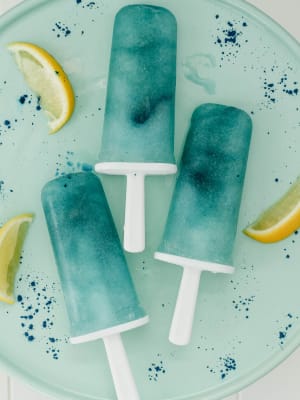Microplastics and Nutrition: Detoxing in the Plastic Age

Microplastics and Nutrition: Detoxing in the Plastic Age
Microplastics and nanoplastics are everywhere - in our breakfast, lunch and dinner. They’re in our clothes, makeup, the air we breathe, and every tissue in our body. Here’s what we know, and most importantly, what we can actually do about it.
In This Article, You'll Learn:
- How microplastics and nanoplastics have infiltrated every single corner of our lives.
- Effective and practical steps to actually minimize your daily exposure.
- Which foods have been shown to contain the most plastic.
- Real nutritional strategies to protect your body from the plastic we can't avoid.
Plastic Planet
It's remarkable to consider that before the late 19th century, plastic didn't even exist on planet Earth. Fast-forward to the present, and plastic accounts for 90 per cent of all waste floating in the oceans. It's embedded in our phones, cars, and kitchenware, making up virtually everything we use daily. It's even seeped into every ecological niche imaginable—from the peaks of Mount Everest to the depths of the Mariana Trench.
Microplastics are particles smaller than 5 millimetres; nanoplastics, their even scarier cousins, are under 1000 nanometers (100 to 80,000 times smaller than the width of a human hair). Advanced detection technology has found them in dust, bottled and tap water, the air we breathe, and all types of food to varying degrees. They've been measured in human blood, feces, semen, breast milk, every organ (including the brain), and even the placenta. The sad truth is that babies are hit hardest: meconium, a newborn's first stool, already contains significant amounts of detectable plastics.
Recent estimates have suggested that the average person will swallow, breathe, and otherwise absorb between 74,000 and 121,000 microplastic particles annually. And that might be an underestimate.
They also function like microscopic sponges: plastic particles harbour other chemicals like paints and pollutants, generating ideal surfaces for harmful bacteria congregating and building sticky biofilms. The biofilms, in turn, trap heavy metals like lead and arsenic. All of this means that the plastic is rarely just plastic on its own, but more of a Trojan Horse. Microplastics can be localized to the gut, which means we can excrete them, but nanoplastics have a much easier time passing through the intestinal wall into the blood, where they can circulate systemically, pass through the blood-brain barrier, and accumulate in pretty much every type of tissue.
Since they're everywhere in the environment and body, there's no limit to where they will show up or how they might wreak havoc. While our science on human health consequences is still very much in its infancy, mounting evidence ties long-term exposure to gut inflammation, liver dysfunction, oxidative stress, cardiovascular aging, and reproductive harm.
Everyday Tips for Minimizing Exposure
The bad news is that there is no way to avoid microplastics entirely, and they are already in your body. The good news is that you can dramatically reduce your exposure with a handful of truly effective everyday swaps.
Takeout containers, whether styrofoam, black, or clear plastic, are a huge culprit. People who routinely eat takeout risk swallowing much more plastic. If you needed a sign to cook for yourself a bit more, this is it!
Ditch plastic cutting boards completely in favour of wood. Otherwise, every single slice will shed invisible particles into your food. This also highlights a key plastic principle: plastic is one thing, but damaged, eroded, chipped, or worn plastic is another completely. It's precisely from the physical degradation of bigger plastics that microplastics and nanoplastics are made.
Filter your water. Worldwide, tap water has been shown to contain thousands of particles per litre, and bottled water has even more. To everyone's surprise, a truly alarming French study recently revealed that glass water bottles contained more microplastic particles than plastic water bottles, likely due to how the plastic caps are sealed onto them during manufacturing. Meanwhile, getting a reverse osmosis or carbon water filter for your tap can result in the most plastic-free drinking water possible, even if the filter itself contains plastic.
Heating plastic is a major no-no. Microwaving leftovers in plastic containers or in contact with plastic wrap, sipping hot coffee or tea from lined takeout cups through plastic lids, or leaving water bottles in a hot car or full sun multiplies particle release. Baby bottle nipple materials are especially worth paying attention to, as they can release high loads when repeatedly steam-cleaned.
Consider your cookware. A non-stick pan can be a significant source of exposure, but a scratched non-stick pan can shed literal millions of particles in a single use. You might be much better off using stainless steel with wooden utensils.
Clothing shouldn't be underestimated, either. Synthetic fabrics like polyester, acrylic, and nylon can release thousands of microscopic fibres per wash. Tight-fitting athletic attire is a particular public health concern because heat and friction increase plastic shedding and transdermal absorption.
Choose natural cosmetics wherever possible. Elements like glitter and microbeads are literally plastic by design. Even beyond such intentionally added plastic features, many apparently innocent lotions and creams sneakily harbour polymer additives.
These habits can be thought of like a budget: you'll never reach zero, but cutting back where it's easiest, or where your lifestyle presents the most significant opportunity, can absolutely make a real and measurable difference.

The Most Plastic-Contaminated Foods
Here's where the science gets a little queasy: microplastics have infiltrated our food chain at just about every level. As a result of ocean pollution, researchers estimate that consistent seafood eaters, in particular, may ingest up to 11,000 extra plastic particles per year. Crustaceans and small fish consumed whole (sardines, anchovies) are the worst offenders.
Other significant sources:
Salt. A South Korean study found that 36 of 39 table salt brands tested contained significant amounts of microplastics. Sea salt and, to a lesser degree, rock salt are also possible routes of daily exposure.
Soda and Beer. Brewing and bottling introduce measurable microplastic contamination. As with bottled water, this issue seems to transcend glass or plastic bottling. Beer, mainly, has been found to host troublesome concentrations partly due to packaging and partly due to wheat itself.
Tea bags. Slick, shiny plastic tea bags can shed billions of nylon and other fragments into a single cup of hot brewed tea. For example, making loose-leaf tea in a glass French press would be an excellent swap for regular tea drinkers.
Produce. Studies have shown that nanoplastics can be transported up through roots and stems into edible leafy components of various crops. Apples and carrots seem particularly prone to accumulating plastic particles, but no fruit or veggie is immune. Local organic produce, when accessible, may help reduce the burden in this regard.
Honey. As they travel around collecting pollen and nectar, bees inadvertently also collect plastic fragments from the environment and carry them back into hives. When honey is packaged in plastic packaging, the number of particles in each spoonful may be further increased.
So, basically, the more packaged, processed, or industrially farmed food you eat, the more plastic you're likely to consume. It's not paranoia—it's real and measurable.
Nutrition to the Rescue: What Can We Do to Detox and Protect Ourselves?
Now let's get to the hopeful part: thankfully, diet isn't just a source of plastic - it may also be a massive part of the solution.
Fibre, fibre, fibre. High-fibre diets regulate intestinal motility, potentially helping to flush away ingested microplastics before they further degrade into the nanoplastics that get absorbed into general circulation. Beyond the plastic we breathe in or absorb through our skin, the overwhelming majority of it gets swallowed. This highlights our food and drink choices and points to the central importance of gut health.
Polyphenols and antioxidants. Oxidative stress is primarily how microplastics wreak havoc on us at a cellular level. Polyphenol-rich foods such as green tea, turmeric, and berries can protect us from free radical damage.
Algae and binding agents. Both spirulina and chlorella have shown great promise in binding to harmful toxins, helping to escort them out for excretion.
Hydration. Adequate water intake supports kidney filtration and gut health. Since the kidneys are major detox organs in their own right, helping them function happily is never a bad thing. Remember, of course, that filtered water is best.
Emerging bioactive compounds. Recent research has cast an exciting spotlight on compounds like melatonin, astaxanthin, probiotics, and luteolin as potential shields against plastic-induced oxidative stress.
None of this means that you can "detox" plastics with supplements or a green smoothie. However, the evidence does suggest that your nutritional status can tip the balance, either reducing toxic effects of plastic intake, or helping your body mount a real defence to it.
A Species-Level Problem
It's tempting to see navigating our plastic planet as a question of personal consumption choices. And it's true: bringing your own stainless steel mug, switching to loose-leaf tea, and trading your plastic cutting board for a wooden alternative will definitely help. In some cases, such as reducing takeout orders or cutting back on beer, we'll be taking steps in a healthier direction regardless of plastic contamination.
Ultimately, the scale of the problem is bigger than you or me, and it really affects the whole planet and the whole human species.
Despite recycling efforts, a staggering 79 per cent of all plastics produced in the last 75 years have ended up in landfills, lakes, oceans, and the rest of our environment. Single-use plastics continue to dominate modern consumption habits. Beyond individual habits, it's policy and regulation that will be the real determining factors going forward. Restrictions on single-use packaging, incentives for bioplastic development, and overhauls in approaches to agriculture and waste management are already underway in some parts of the world.
In the grand scheme of things, actions on that level will undoubtedly be more impactful than any one person's reusable tote bag. But personal choices are by no means meaningless. They send real market signals, protect you and your family's health, and align daily habits with broader cultural momentum.
The bottom line is that plastics were designed to last forever. The question for all of us now, both collectively and as individuals, is what we will do with the burgeoning awareness of just how profoundly they're impacting our bodies and our planet.
Microplastic FAQs:
How much plastic do we eat every year? Between 40,000 and 120,000 particles, depending on lifestyle and location. It's been estimated that we each swallow roughly 17 credit cards' worth of plastic every year.
Which foods contain the most? Seafood, beer, coffee, tea, table salt, soda, honey, root veggies, and some produce standouts like carrots and apples. Food that is packaged or processed with plastic is also prone to contamination.
What's the difference between microplastics and nanoplastics? Microplastics are anything smaller than 5 mm in diameter; nanoplastics are anything below 1000 nanometers (that's smaller than most bacteria).
Can diet help in any way? Yes! Foods high in fibre, antioxidants, and omega-3s may reduce retention of microplastics and/or their toxic effects.
Is it possible to avoid plastic completely? Nope. However, conscious choices, not to mention society-level policy change, can significantly reduce exposure and related health risks.
Balch, B. (2024, June 27). Microplastics are inside us all. what does that mean for our health?. AAMC. https://www.aamc.org/news/microplastics-are-inside-us-all-what-does-mean-our-health
Bocker, R., & Silva, E. K. (2025). Microplastics in our diet: A growing concern for human health. Science of The Total Environment, 968, 178882. https://doi.org/10.1016/j.scitotenv.2025.178882
Borrelli, L. (n.d.). Your meals are probably covered in microplastics . these 7 kitchen items may be to blame. CNET. https://www.cnet.com/health/you-just-ate-a-side-of-plastic-for-dinner-blame-these-kitchen-items-full-of-microplastics/
Dutchen, S. (2025, June 13). Microplastics everywhere. Harvard Medicine Magazine. https://magazine.hms.harvard.edu/articles/microplastics-everywhere
FDA. (n.d.). Microplastics and Nanoplastics in foods. U.S. Food and Drug Administration. https://www.fda.gov/food/environmental-contaminants-food/microplastics-and-nanoplastics-foods
Frasquet, R. (2025, June 20). Glass bottles found to contain more microplastics than plastic bottles. Phys.org. https://phys.org/news/2025-06-glass-bottles-microplastics-plastic.html
Gajbhiye, S. (n.d.). Plastics found inside vegetable tissues for the first time, raising new food safety concerns. Earth.com. https://www.earth.com/news/plastics-found-inside-vegetable-tissues-for-the-first-time/
Gerretsen, I. (2023, January 5). How microplastics are infiltrating the food you eat. BBC News. https://www.bbc.com/future/article/20230103-how-plastic-is-getting-into-our-food
Higgins, G. (2024, February 6). You are what you eat: Plastics in our food. Earth Day. https://www.earthday.org/you-are-what-you-eat-plastics-in-our-food/
Jahedi, F., & Jaafarzadeh Haghighi Fard, N. (2025). Micro- and nanoplastic toxicity in humans: Exposure pathways, cellular effects, and Mitigation Strategies. Toxicology Reports, 14, 102043. https://doi.org/10.1016/j.toxrep.2025.102043
Joseph, J. (n.d.). Scientists warn that Your morning cup of coffee or tea is likely full of invisible microplastics. Earth.com. https://www.earth.com/news/your-morning-cup-of-coffee-or-tea-is-likely-full-of-invisible-microplastics/
Kadac-Czapska, K., Knez, E., & Grembecka, M. (2022). Food and human safety: The impact of microplastics. Critical Reviews in Food Science and Nutrition, 64(11), 3502–3521. https://doi.org/10.1080/10408398.2022.2132212
Lamoree, M. H., van Boxel, J., Nardella, F., Houthuijs, K. J., Brandsma, S. H., Béen, F., & van Duursen, M. B. (2025). Health impacts of microplastic and nanoplastic exposure. Nature Medicine, 31(9), 2873–2887. https://doi.org/10.1038/s41591-025-03902-5
LaMotte, S. (2024, April 22). Which foods have the most plastics? you may be surprised. CNN. https://www.cnn.com/2024/04/22/health/plastics-food-wellness-scn
Li, Y., Tao, L., Wang, Q., Wang, F., Li, G., & Song, M. (2023). Potential health impact of microplastics: A Review of Environmental Distribution, human exposure, and toxic effects. Environment & Health, 1(4), 249–257. https://doi.org/10.1021/envhealth.3c00052
Morath, S. J. (n.d.). Solving the world’s microplastics problem: 4 solutions cities and states are trying after Global Treaty talks collapsed. Yahoo! News. https://www.yahoo.com/news/articles/solving-world-microplastics-problem-4-122950365.html?guccounter=2
Nanoplastics are everywhere: What is the health impact of these tiny particles?. UK Health Security Agency. (2025, March 12). https://ukhsa.blog.gov.uk/2025/03/12/nanoplastics-are-everywhere-what-is-the-health-impact-of-these-tiny-particles/
Nanoplastics Disrupt Brain Energy, threatening memory function. Neuroscience News. (2025, September 15). https://neurosciencenews.com/nanoplastics-memory-neuroplasticity-299684/
Okamoto, K. (n.d.). Microplastics are everywhere. here’s how to avoid eating them. The New York Times. https://www.nytimes.com/wirecutter/reviews/how-to-avoid-eating-microplastics/
Perkins, T. (2025, March 3). What you can do about microplastics in your food. Consumer Reports. https://www.consumerreports.org/health/food-contaminants/what-you-can-do-about-microplastics-in-your-food-a8408022729/
Schwarcz, J. (2024, January 11). Macropanic over nanoplastics?. Office for Science and Society. https://www.mcgill.ca/oss/article/critical-thinking-health-and-nutrition/macropanic-over-nanoplastics
Sinha Dutta, S. (2025, May 21). Microplastics in ultra-processed foods may fuel mental health risks, experts warn. News. https://www.news-medical.net/news/20250521/Microplastics-in-ultra-processed-foods-may-fuel-mental-health-risks-experts-warn.aspx
Wang, H., Wang, Z., Zhang, S., Du, C., Zhang, X., Wang, L., & Huang, J. (2024). Fighting microplastics: The role of dietary fibers in protecting health. Food Frontiers, 5(5), 1984–1998. https://doi.org/10.1002/fft2.437
Ziani, K., Ioniță-Mîndrican, C.-B., Mititelu, M., Neacșu, S. M., Negrei, C., Moroșan, E., Drăgănescu, D., & Preda, O.-T. (2023). Microplastics: A real global threat for environment and food safety: A state of the art review. Nutrients, 15(3), 617. https://doi.org/10.3390/nu15030617
Lead photo by Marc Newberry on Unsplash.



